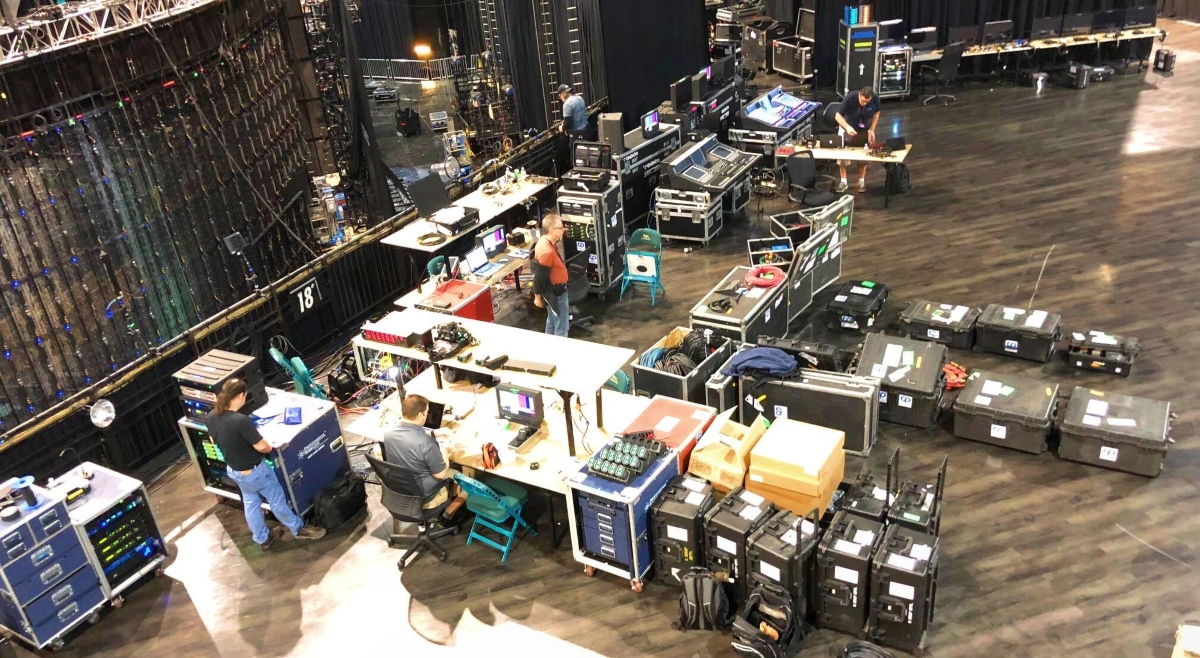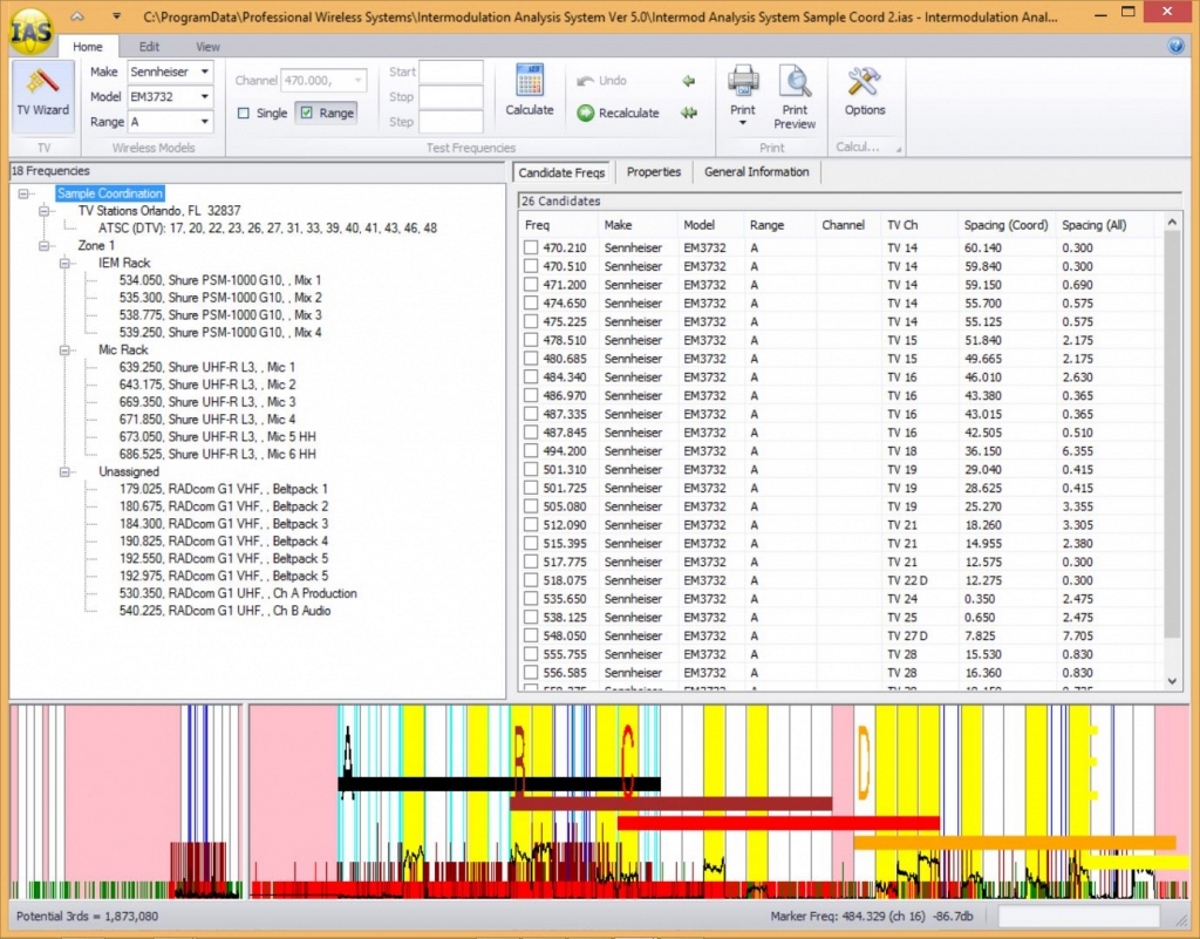
As an antidote to this loss of more and more spectrum, PWS engineers have begun deploying equipment that is more spectrally efficient, thereby giving themselves the capability to fit more devices within a significantly smaller wireless footprint. To tightly tune and optimize reception, RF filtering also plays a hugely important role within the company’s current plans to cope with ongoing changes, as does new gear that offers more flexibility.
“Prior to this latest loss of spectrum, we typically used a common core of UHF-based equipment that coexisted peacefully among TV channels,” Trenda adds. “We could more easily cover the needs of a broad spectrum of shows with UHF band equipment. Now, frequency coordination and bandwidth planning have become much more critical because we have to specify gear in multiple frequency bands. This work needs to be done well in advance, and there will only be certain frequency ranges of equipment that will operate in certain cities.
“Concurrently, we’re showing up on-site with a new generation of components that are highly versatile. Some of these systems used to operate solely within the UHF bands, but now they’re even offering VHF alternatives, something most of us would not have considered using previously. Similarly, intercom systems that operate in the 1.9 or 2.4 GHz ranges are being used increasingly.”
Making It Flow
PWS is also considering how it approaches its workflow more than ever before. In the pre-600 MHz auction world, we once knew, dealing with a high number of transmitters in large venues was a bit simpler. These environments could be dealt with by increasing the power and channel count.
“More power is not necessarily better anymore,” Jim Van Winkle points out. “This is especially true at a corporate level, where we are deploying hundreds of frequencies through a convention center or hotel with a general session area and several breakout rooms. In these cases, we’re utilizing lower power transmitters now – as low as 1 milliwatt (mW) – with more localized antennas.

“Given that frequencies are more limited than ever, we have to share them throughout a given environment between different rooms. It’s not a one-size-fits-all approach these days: We can use the same frequencies in one or two rooms on the same floor, or different floors, all with low power transmission to steer clear of interference. That’s a big change in how we approach our workflow for sure, and sets the tone for future productions.”
According to Jim Van Winkle, the same workflow approach now carries over to large studios owned by broadcasters like the Golf Channel or NBC Sports, where PWS has setup distributed antenna systems that let them mic-up talent in one place with a single microphone, and then that person can travel to several different studios throughout the building without ever changing his or her mic.
Outside of the corporate and broadcast worlds, many know PWS for its high-profile work at awards shows like the Latin Grammys and the Super Bowl. In these kinds of applications where the whole world or at least a good portion of it is watching and listening, change is just as widespread as everywhere else.
“In comparison to last year, this year’s Super Bowl halftime show was placed on a much larger footprint,” Cameron Stuckey reveals. “So to provide seamless coverage, we implemented multiple zones of discrete antenna systems backed by fiber optic transport for the first time. This represents another change in our workflow strategy. While we obtained the same coverage as we would have using copper-based systems in the past, we kept our antennas closer in the different performance zones rather than having an antenna based further away covering a much larger area.
“Although the spectrum available to us is shrinking, the areas of coverage we’re asked to provide are growing. Fiber optic transport is a natural in these situations because there is zero line loss. With fiber, we take an electromagnetic wave – which is RF energy – convert it to light, and then once we arrive at our destination, we convert it back to RF. Our signal path is as small as it has ever been as a result, even if we are transmitting to the opposite end of a stadium.”
Handy Tool
Finally, viewed as a must-have to help sort through the complexities of current and future wireless operations, PWS has turned to specialized software and the power of the computer to reduce the amount of time required for frequency coordination.
As the creators of IAS (Intermodulation Analysis System), the company provides a tool with the ability to look up local television frequencies in use in areas around the country, and produce a list of coordinated frequencies across multiple zones. IAS also includes a database of equipment from most major wireless manufacturers.

“With IAS, once an engineer or tech enters their current location and an inventory of their gear, the software will perform all the calculations necessary to produce a list of coordinated frequencies,” Jim Van Winkle says on a closing note. “These frequencies will be free from overlapping digital TV signals and intermodulation. Compared to the trial-and-error methods of the past, IAS saves a huge amount of time and effort.
“As we find ourselves working in environments defined by useable spectrum as well as a minefield of other challenges and unknowns, IAS is something that stands out with clarity amid the confusion. Right now, that’s a comforting notion, and a big step toward helping to provide our clients with solid, trouble-free wireless performance for years to come.”
